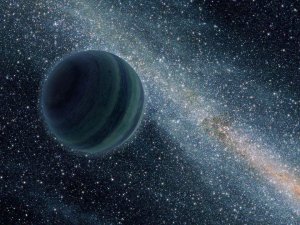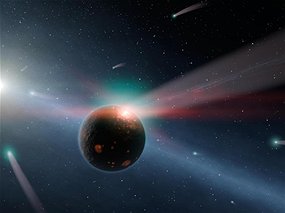

A rogue planet (or a free floating planet) is generally a Jupiter sized body that inhabits the space between stars, unbound by the gravity of a parent star. It’s believed that these planets either formed directly from the collapse of interstellar gas clouds (like stars) without having the mass to ignite (like a brown dwarf), or they were formed in a planetary system and they somehow overcame the gravity of their star and were ejected from the system (how sad for them).
This happens when a planet, that’s usually of large mass, migrates inwards towards its parent star. In the process, it plows through the remaining materials left-over from the systems formation. Naturally, any planets in between the migrating planet and the star will be affected. Some of the planets will shift their orbit (moving closer or farther from their host star), some could be set on a collision course with another object (a moon or another planet, ultimately becoming destroyed), others might be ejected from the system entirely.
More Common Than Stars:
Let’s say an inward moving planet is five times the mass of Jupiter. It can gravitationally eject a smaller planet. Even one that’s as massive as Jupiter! This implies that there could be several rogue planets that were ejected from every system that has a hot Super-Jupiter orbiting its parent star from a close proximity (in fact, such scenarios are likely). Believe it or not, we’ve recently discovered that these rogue planets are VERY common. In fact, there may be nearly twice as many of them as there are stars!

Unfortunately, they are still pretty difficult to observe since they have no discernible effect on a parent star. Instead of looking for blips of lights as a planet passes in front of its star as it makes a normal transit, to track these rogue planets, we monitor the skies, watching for the effect of the planet on background stars that are much, much more distant than the planets themselves. They warp the light of the background star, causing it to magnify and brighten. This also makes smaller rogue planets almost impossible to monitor with our current technology. So even if we find one, it will be exceedingly hard to track. But these (technically) should be more numerous than Jupiter-sized bodies.
Could Life Thrive On One?
As for the habitability of these loner planets, they are EXTREMELY cold, but maybe they aren’t as cold as you would expect them to be in the abyss that is interstellar space. Certain gas-giants, like Jupiter and Saturn, give off more energy than they receive from the sun. Apart from the heat generated during the contraction of the planet’s core, radioactive decay is a source of heat that captures a considerable amount of the heat generated during the inception of the planet. So any of these nomad planets might remain gaseous, despite the intense cold. It’s also possible (but unlikely) for some of these planets to retain their moon(s) upon ejection. Tidal heating would be another source of warmth for any of these planets lucky enough to keep their moon.